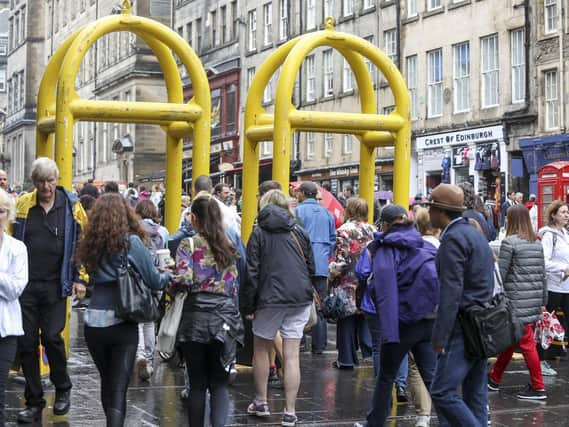Campaigners want traffic-free Edinburgh Festival streets to tackle 'intolerable" congestion problems


Campaigners want the Canongate, the Cowgate and the Lawnmarket to be among the streets targeted for pedestrianisation next August.
Their calls have emerged after crush barriers were put in place in some of the most congested areas to reduce the risk of festival-goers stepping into traffic.
Advertisement
Hide AdSenior councillors have revealed that a full review has been ordered which will examine how different parts of the city centre coped with the festivals, tackle the most acute congestion problems and explore how events could be better spread around Edinburgh.
The announcement was made after final day box office figures revealed a record 2.8 million Fringe tickets had been sold - an increase of a million in less than a decade.
Heritage and environment campaigners have thrown their weight behind a major expansion of pedestrianisation in August ahead of a number of expected traffic-free trials that are being explored by the council as part of a city-wide year-round project.
In an open letter to council leader Adam McVey, Living Streets Edinburgh has urged him to take “urgent” action to improve the safety of the city.
It has also called on the local authority to ensure better late night bus and train services are in place next year as part of a shake-up of how the festivals are managed.
Adam Wilkinson, director of Edinburgh World Heritage, said: “In addition to the well-known negative health effects, heavy traffic and congestion has been shown to damage the fragile historic fabric of our city, and prevent its full enjoyment and appreciation by both residents and visitors.
Advertisement
Hide Ad“Many European cities operate far more restrictive traffic regimes within their historic centres, including extensive pedestrianisation, appropriate public transport solutions, as well as restrictions on deliveries – both in terms of time of day and size of vehicle.
“We look forward to working with the city council on a range of long-term solutions.”
Advertisement
Hide AdDavid Spaven, convener of Livings Streets Edinburgh said: “We’ve been calling for restrictions on private traffic during the summer festival for several years.
“We believe that the experience for pedestrians, hemmed into narrow streets surrounded by traffic has become intolerable.
“The festival experience would be hugely enhanced - and made much safer - by excluding much motor traffic from city centre streets during August.
“Each year, this becomes more urgent - in 2018 it has come to the stage that new barriers have been widely used to keep pedestrians out of the road.”
Council leader Adam McVey said: “We proudly welcome people from all over Scotland and the world to come and enjoy our incredible festivals and this has been another record-breaking summer for us. But with so many thousands of additional people in the city, there inevitably comes an increased demand on our services and some important concerns have been raised.
“We’re already taking positive strides towards improving the balance for residents. This summer festival activity spread further afield to Leith while Cockburn Street was pedestrianised to help ease congestion, and public transport increased in frequency. In addition to 24-7 buses, Edinburgh Trams introduced a late night timetable, which clearly proved popular – this was their busiest August yet, with more than 600,000 journeys made.
Advertisement
Hide Ad“In the longer term, we are committed to improving pedestrian access, not just during August but throughout the year.
“As part of our ambitious City Centre Transformation project we want to make travel by foot or by bike as safe and enjoyable as possible, opening up the city to create welcoming, accessible public spaces, and transport will be central to this.”